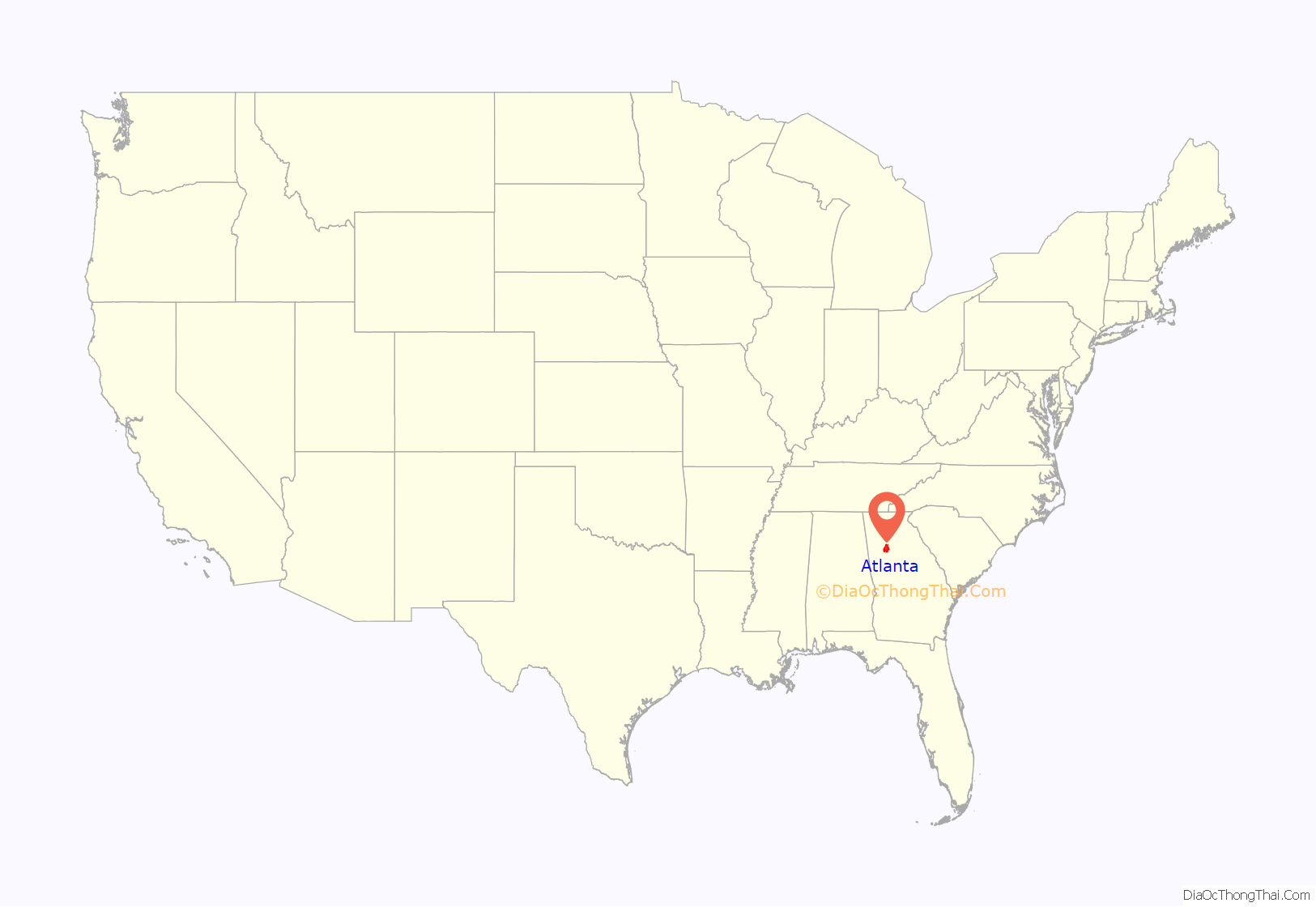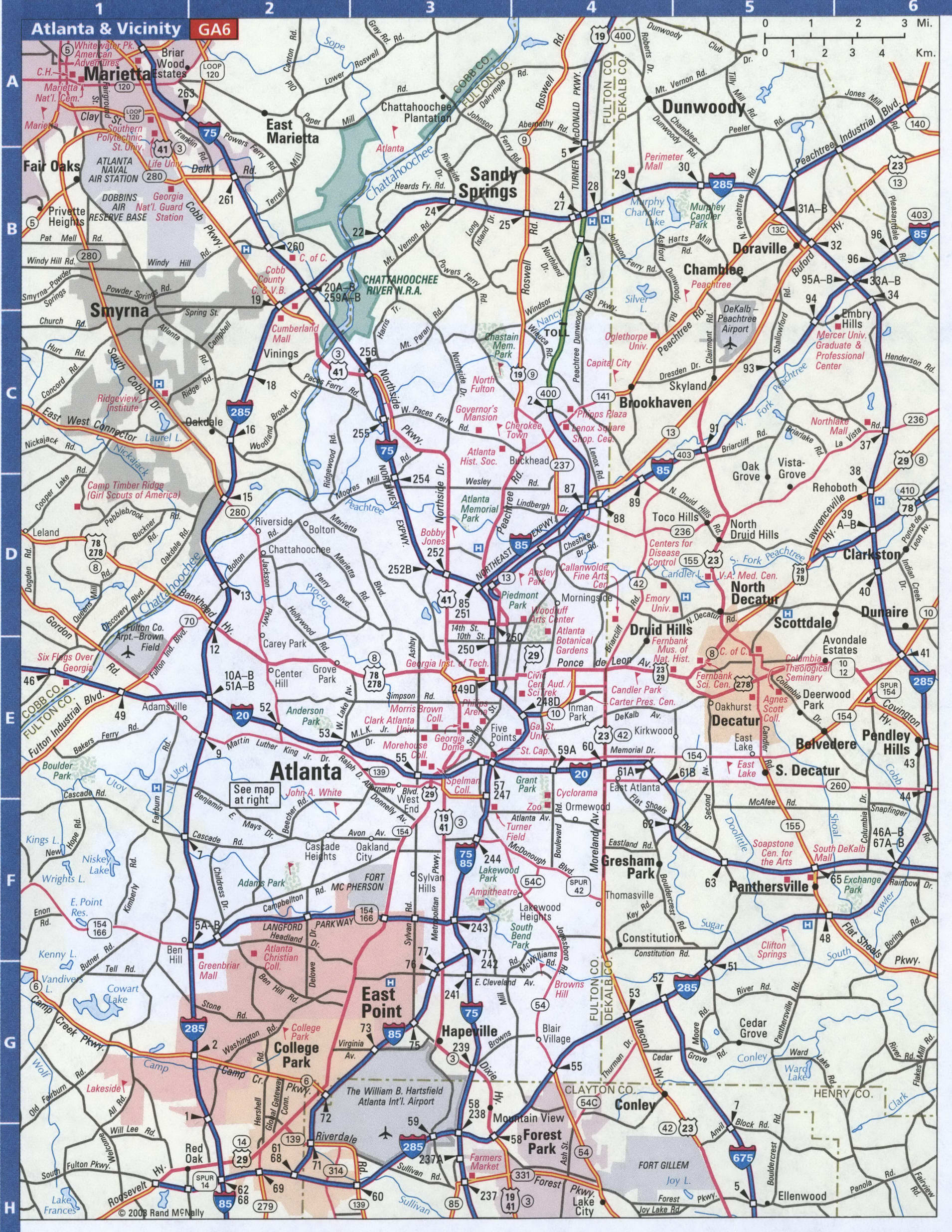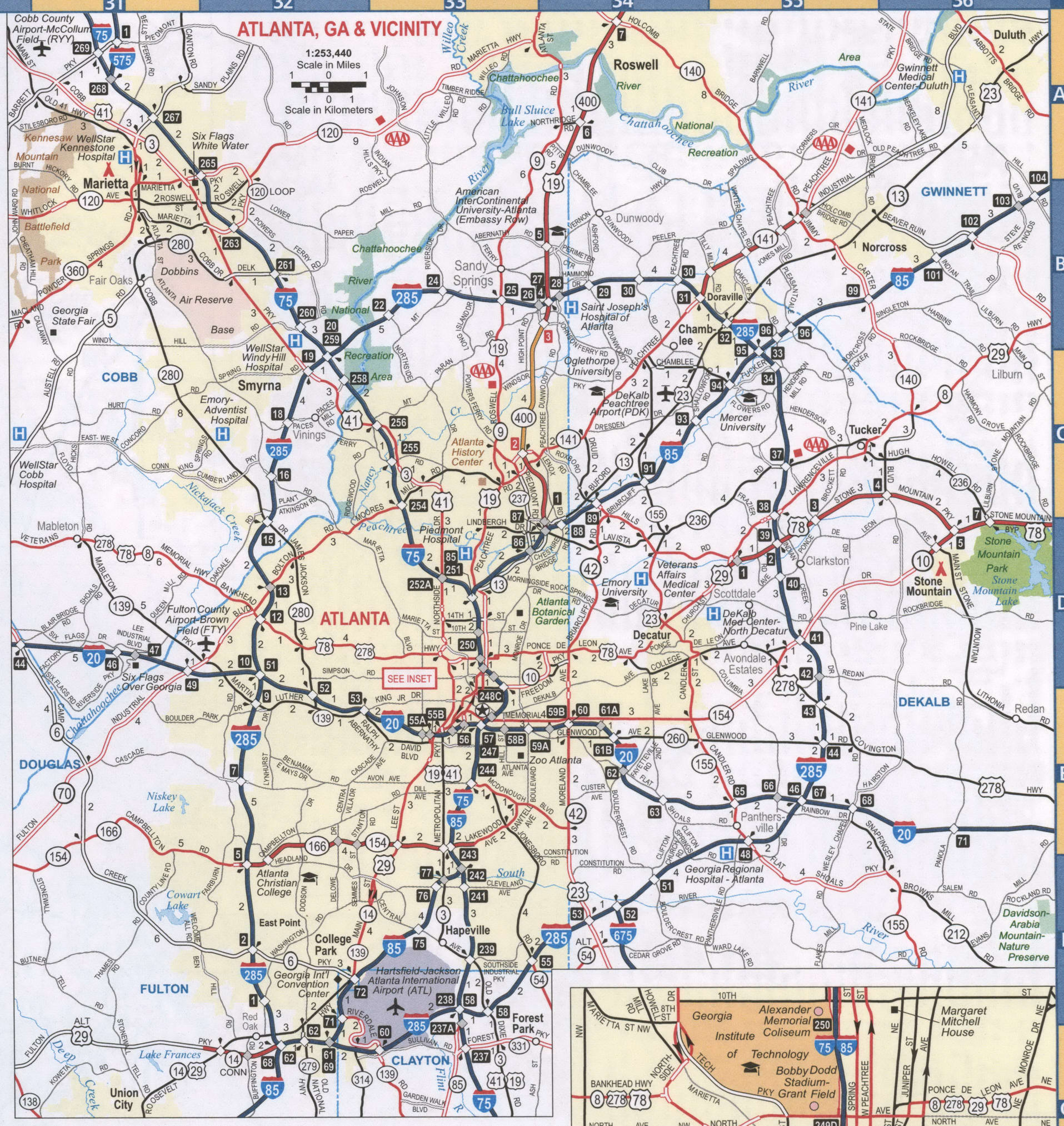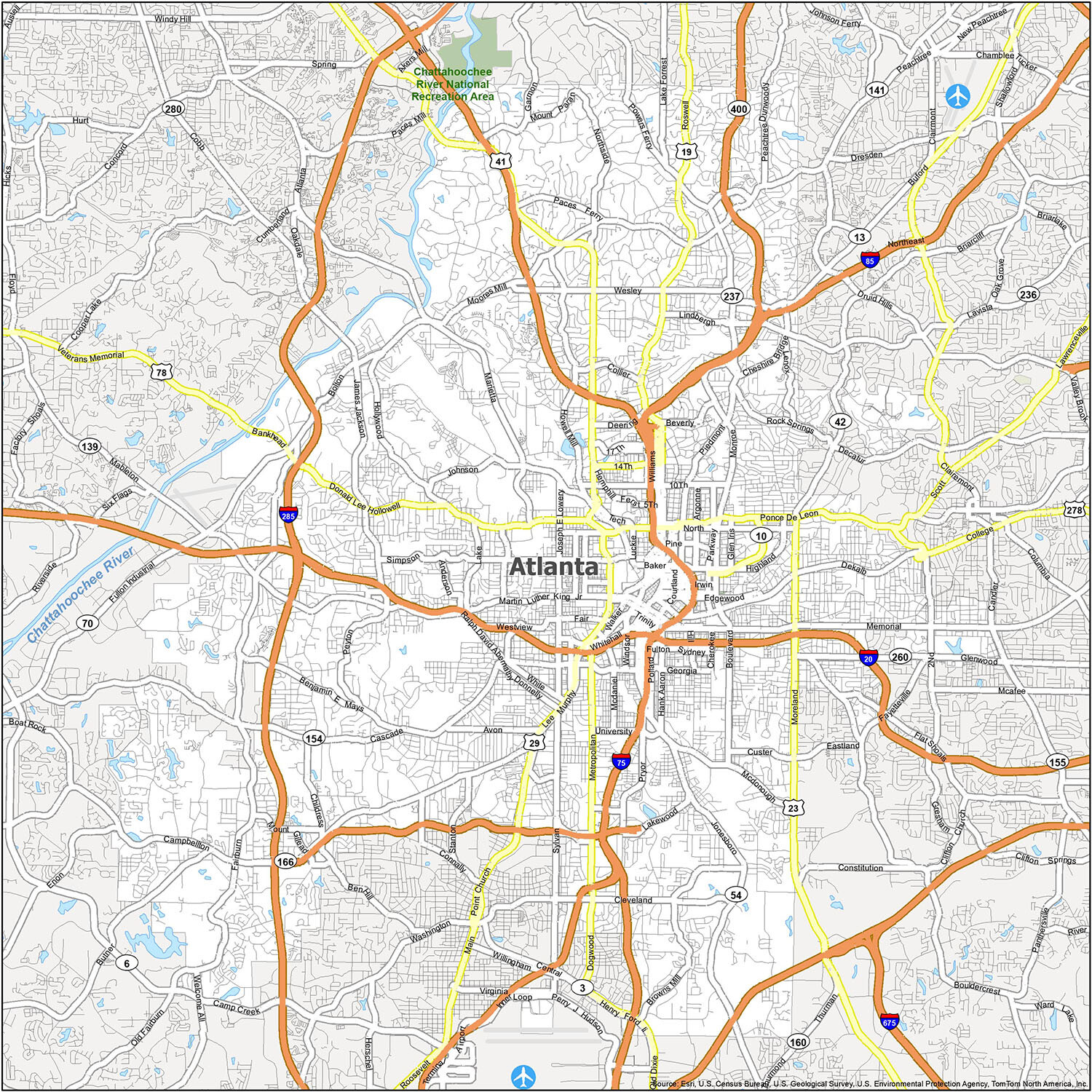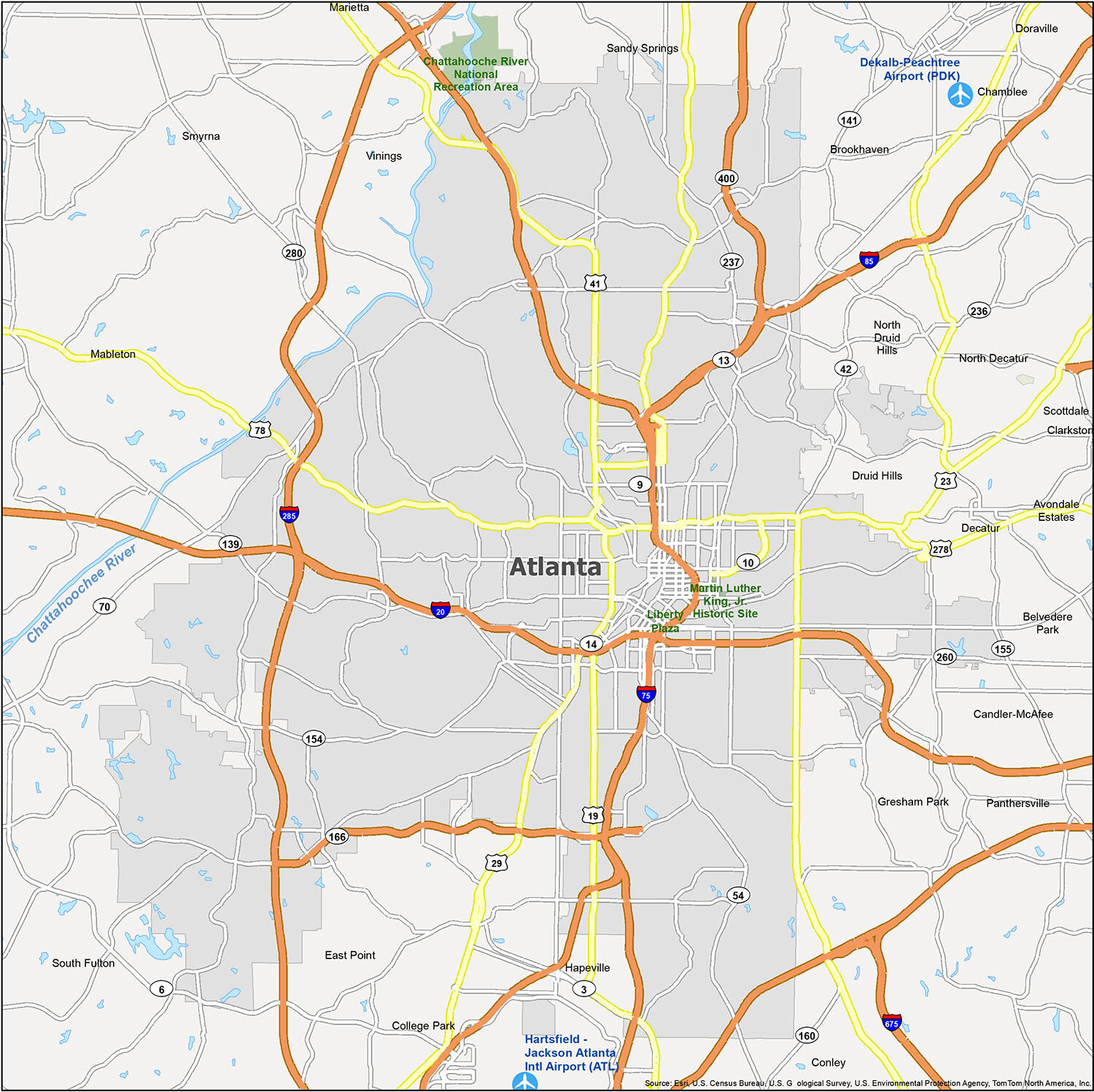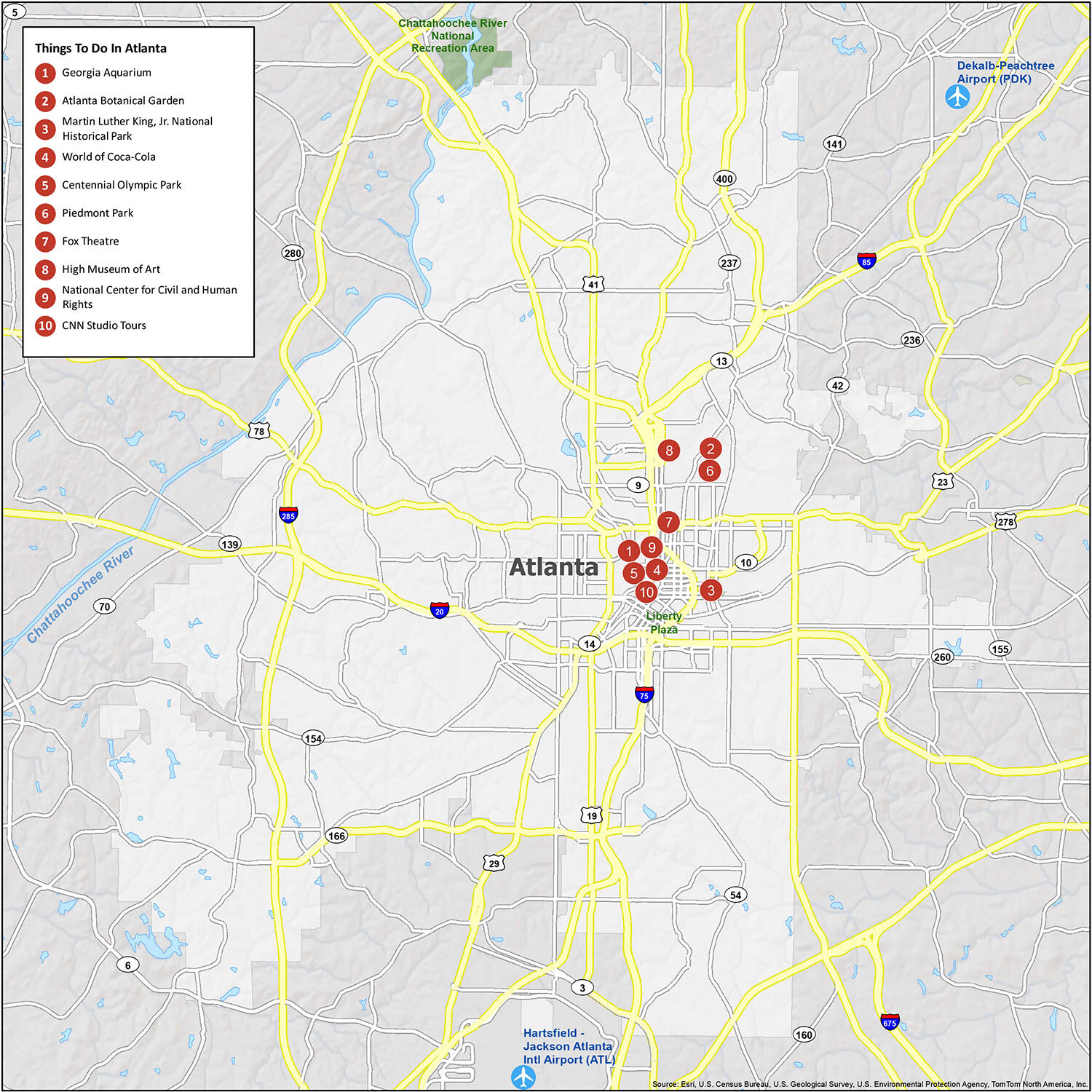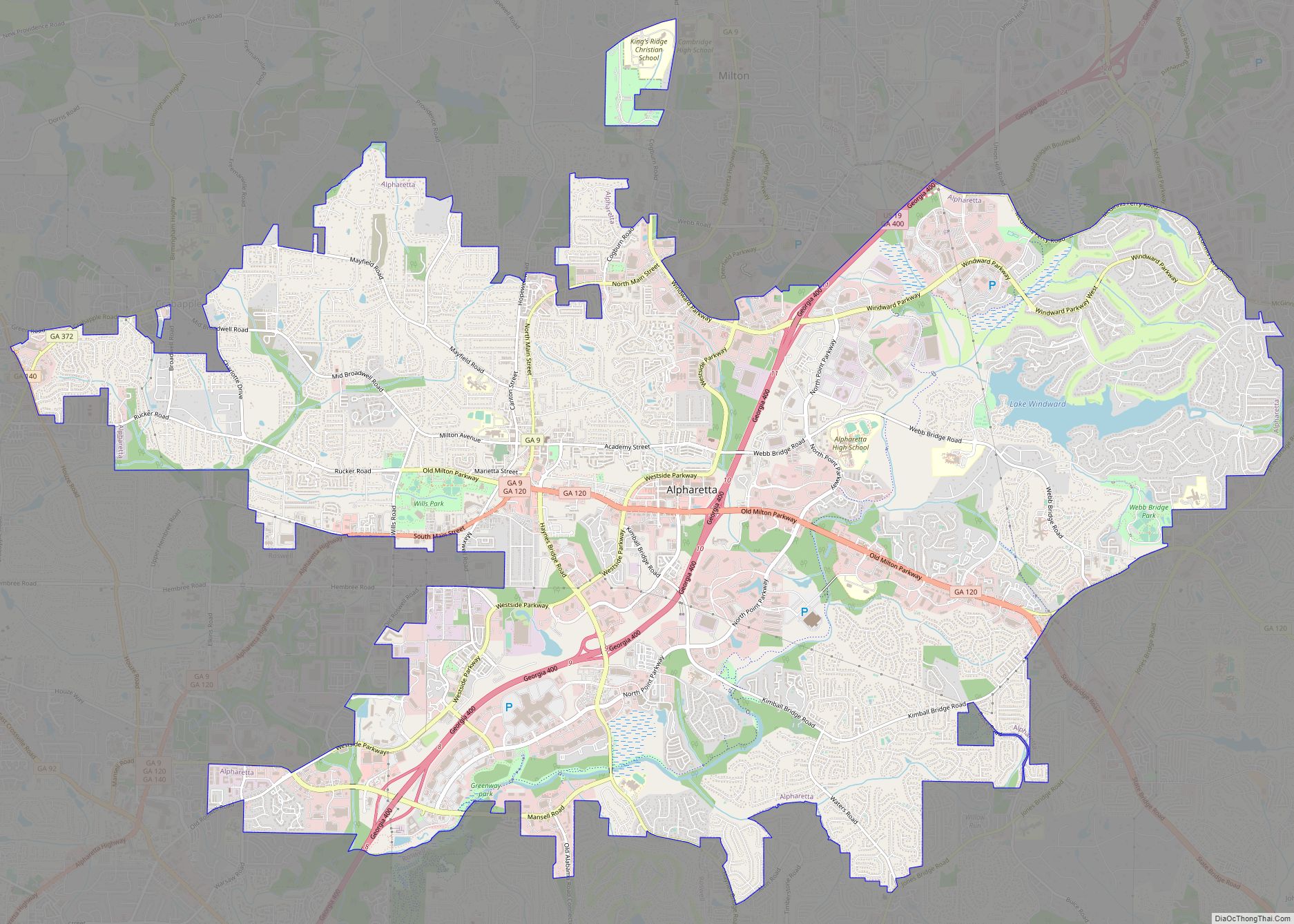Atlanta (/ætˈlæntə/ at-LAN-tə) is the capital and most populous city of the U.S. state of Georgia. It is the seat of Fulton County, the most populous county in Georgia, although a portion of the city extends into neighboring DeKalb County. With a population of 498,715 living within the city limits, it is the eighth most populous city in the Southeast and 38th most populous city in the United States according to the 2020 U.S. census. It is the core of the much larger Atlanta metropolitan area, which is home to more than 6.1 million people, making it the eighth-largest metropolitan area in the United States. Situated among the foothills of the Appalachian Mountains at an elevation of just over 1,000 feet (300 m) above sea level, it features unique topography that includes rolling hills, lush greenery, and the most dense urban tree coverage of any major city in the United States.
Atlanta was originally founded as the terminus of a major state-sponsored railroad, but it soon became the convergence point among several railroads, spurring its rapid growth. The largest was the Western and Atlantic Railroad, from which the name “Atlanta” is derived, signifying the city’s growing reputation as a major hub of transportation. During the American Civil War, it served a strategically important role for the Confederacy until it was captured in 1864. The city was almost entirely burnt to the ground during General William T. Sherman’s March to the Sea. However, the city rebounded dramatically in the post-war period and quickly became a national industrial center and the unofficial capital of the “New South”. After World War II, it also became a manufacturing and technology hub. During the 1950s and 1960s, it became a major organizing center of the American Civil Rights Movement, with Martin Luther King Jr., Ralph David Abernathy, and many other locals becoming prominent figures in the movement’s leadership. In the modern era, Atlanta has stayed true to its reputation as a major center of transportation, with Hartsfield-Jackson International Airport becoming the world’s busiest airport in the country by passenger traffic in 1998 (A position it has held every year since, with the exception of 2022 by 93.6 million passengers).
With a gross domestic product (GDP) of $406 billion, Atlanta has the tenth largest economy of cities in the U.S. and the 20th largest in the world. Its economy is considered diverse, with dominant sectors in industries including transportation, aerospace, logistics, healthcare, news and media operations, film and television production, information technology, finance, and biomedical research and public policy. The gentrification of some its neighborhoods, initially spurred by the 1996 Summer Olympics, has intensified in the 21st century with the growth of the Atlanta Beltline. This has altered its demographics, politics, aesthetics, and culture.
| Name: | Atlanta city |
|---|---|
| LSAD Code: | 25 |
| LSAD Description: | city (suffix) |
| State: | Georgia |
| County: | DeKalb County, Fulton County |
| Elevation: | 1,050 ft (320 m) |
| Land Area: | 135.32 sq mi (350.48 km²) |
| Water Area: | 0.99 sq mi (2.57 km²) |
| Population Density: | 3,685.45/sq mi (1,422.96/km²) |
| FIPS code: | 1304000 |
| GNISfeature ID: | 351615 |
| Website: | atlantaga.gov |
Atlanta is the perfect place to explore and discover the South. From the World of Coca‑Cola to the world’s busiest airport, Hartsfield–Jackson Atlanta International Airport, there is something for everyone in this vibrant city. Find the perfect place for your next trip with our Atlanta map collection.
Discover what makes Atlanta great with this comprehensive guide to the city’s neighborhoods, attractions, and sights. Explore major highways with a printable road map of Atlanta, or find the top 10 things to do and major landmarks like Martin Luther King, Jr. National Historical Park. If you’re going to travel outside of Atlanta, then make sure to also check out our Georgia map. With this Atlanta map collection, you can tour the best neighborhoods, historical sites, and cultural hotspots the city has to offer.
Online Interactive Map
Click on ![]() to view map in "full screen" mode.
to view map in "full screen" mode.
Explore the Atlanta area with this interactive map. Search, explore, and discover what you like and need to know. This map is designed to introduce you to all of the things you can see, do, and eat in the Atlanta area. It’s easy to explore if you’re new or familiar with Atlanta. When you’re on the go, this map can help you find your way around the city. It’s loaded with helpful information, from bus routes to directions to the nearest grocery store and traffic information.
Atlanta location map. Where is Atlanta city?
Atlanta Road Map
One of the best cities in the US is Atlanta, Georgia. With a rich history and diverse culture, Atlanta offers great food, fun attractions, and beautiful natural landscapes. With a population of about 500,000 people, it’s also the capital city of Georgia. This Atlanta map is a comprehensive guide to all of the neighborhoods, attractions, and sights Atlanta has to offer.
Interstate Highways: I-20, I-75, I-85, I-285
US Highways: 19, 23, 29, 41, 78, 278
State Routes: SR-6, SR-10, SR-13, SR-54, SR-70, SR-78, SR-139, SR-141, SR-154, SR-166, SR-236, SR-237, SR-260, SR-280, SR-400
Highways: Bankhead Hwy, Buford Hwy, Old Dixie Hwy
Parkways: Camp Creek Pky, James Jackson Pky, Metropolitan Pky, Donald Lee Hollowell Pky, Northside Pky
Major Roads: 14th St, 16th St, 17th St, Briarcliff Rd, Buckhead Loop, Burton Rd, Campbellton Rd, Candler Rd, Cascade Ave, Clairmont Rd, Cleveland Ave, College Ave, Crown Rd, Fulton Industrial Blvd, Glenwood Rd, Hamilton E Holmes Dr, Hill St, Isom Way, Jonesboro Rd, Juniper St, Lakewood Ave, Lavista Rd, Lee St, Lenox Rd, Lindbergh Dr, Main St, Martin Luther King Jr Dr, Mcdaniel St, Mcdonough Blvd, Memorial Dr, Moreland Ave, Mount Paran Rd, North Ave, Northside Dr, Paces Ferry Rd, Park Pl, Peachtree St, Peters St, Piedmont Rd, Ponce De Leon Ave, Ralph David Abernathy Blvd, Rhodes Ctr, Roswell Rd, Spring St, State St, Techwood Dr, Trinity Ave, University Ave, Westland Blvd, Whitehall St, Williams St
Atlanta is a vibrant city with a diverse population and neighborhoods. It has a rich history, having played an important role in the American Civil War and Civil Rights Movement. The city is the birthplace of Martin Luther King Jr., a visible figure in the fight for racial equality in the United States. With its historical roots in Atlanta, it’s easy to see why this city has gained so much attention for its attractions.
Atlanta is served by Hartsfield–Jackson Atlanta International Airport (ATL). The city is made up of Atlanta, Avondale Estates, Brookhaven, Chamblee, Clarkston, College Park, Decatur, Doraville, East Point, Forest Park, Hapeville, Marietta, Sandy Springs, Smyrna, South Fulton, Belvedere Park, Candler-McAfee, Conley, Druid Hills, Gresham Park, Mableton, North Decatur, North Druid Hills, Panthersville, Scottdale, and Vinings. Major parks in the area include Liberty Plaza, Chattahoochee River National Recreation Area, and Martin Luther King, Jr. Historic Site.
10 things to do in Atlanta city
Atlanta is a great place for sightseeing and exploring. From the Martin Luther King, Jr. National Historic Site to the World of Coca-Cola, there are plenty of attractions to choose from. Visitors can also enjoy the Georgia Aquarium, Atlanta Botanical Garden, Centennial Olympic Park, Piedmont Park, Fox Theatre, High Museum of Art, National Center for Civil and Human Rights, and the CNN Studio Tours. Whether you’re a local or a tourist, there’s something for everyone in Atlanta!
Atlanta city Satellite Map
Geography
Atlanta encompasses 134.0 square miles (347.1 km), of which 133.2 square miles (344.9 km) is land and 0.85 square miles (2.2 km) is water. The city is situated in the Deep South of the southeastern United States among the foothills of the Appalachian Mountains. At 1,050 feet (320 m) above mean sea level, Atlanta has the highest elevation among major cities east of the Mississippi River. Atlanta straddles the Eastern Continental Divide. Rainwater that falls on the south and east side of the divide flows into the Atlantic Ocean, while rainwater on the north and west side of the divide flows into the Gulf of Mexico. Atlanta developed on a ridge south of the Chattahoochee River, which is part of the ACF River Basin. The river borders the far northwestern edge of the city, and much of its natural habitat has been preserved, in part by the Chattahoochee River National Recreation Area.
Atlanta is 21 miles (33 km) southeast of Marietta, 27 miles (43 km) southwest of Alpharetta, 146 miles (234 km) southwest of Greenville, South Carolina, 147 miles (236 km) east of Birmingham, Alabama, and 245 miles (394 km) southwest of Charlotte, North Carolina.
Atlanta is sometimes called “City of Trees” or “city in a forest”, despite having lost approximately 560,000 acres (230,000 ha) of trees between 1973 and 1999.
Cityscape
Most of Atlanta was burned during the American Civil War, depleting the city of a large stock of its historic architecture. Yet architecturally, the city had never been traditionally “southern” because Atlanta originated as a railroad town, rather than a southern seaport dominated by the planter class, such as Savannah or Charleston. Because of its later development, many of the city’s landmarks share architectural characteristics with buildings in the Northeast or Midwest, as they were designed at a time of shared national architectural styles.
During the late 20th century, Atlanta embraced the global trend of modern architecture, especially for commercial and institutional structures. Examples include the State of Georgia Building built in 1966, and the Georgia-Pacific Tower in 1982. Many of the most notable examples from this period were designed by world renowned Atlanta architect John Portman. Most of the buildings that define the downtown skyline were designed by Portman during this period, including the Westin Peachtree Plaza and the Atlanta Marriott Marquis. In the latter half of the 1980s, Atlanta became one of the early homes of postmodern buildings that reintroduced classical elements to their designs. Many of Atlanta’s tallest skyscrapers were built in this period and style, displaying tapering spires or otherwise ornamented crowns, such as One Atlantic Center (1987), 191 Peachtree Tower (1991), and the Four Seasons Hotel Atlanta (1992). Also completed during the era is the Portman-designed Bank of America Plaza built in 1992. At 1,023 feet (312 m), it is the tallest building in the city and the 14th-tallest in the United States.
The city’s embrace of modern architecture has often translated into an ambivalent approach toward historic preservation, leading to the destruction of many notable architectural landmarks. These include the Equitable Building (1892–1971), Terminal Station (1905–1972), and the Carnegie Library (1902–1977). In the mid-1970s, the Fox Theatre, now a cultural icon of the city, would have met the same fate if not for a grassroots effort to save it. More recently, preservationists may have made some inroads. For example, in 2016 activists convinced the Atlanta City Council not to demolish the Atlanta-Fulton Central Library, the last building designed by noted architect Marcel Breuer.
Atlanta is divided into 242 officially defined neighborhoods. The city contains three major high-rise districts, which form a north–south axis along Peachtree: Downtown, Midtown, and Buckhead. Surrounding these high-density districts are leafy, low-density neighborhoods, most of which are dominated by single-family homes.
Downtown Atlanta contains the most office space in the metro area, much of it occupied by government entities. Downtown is home to the city’s sporting venues and many of its tourist attractions. Midtown Atlanta is the city’s second-largest business district, containing the offices of many of the region’s law firms. Midtown is known for its art institutions, cultural attractions, institutions of higher education, and dense form. Buckhead, the city’s uptown district, is eight miles (13 km) north of Downtown and the city’s third-largest business district. The district is marked by an urbanized core along Peachtree Road, surrounded by suburban single-family neighborhoods situated among woods and rolling hills.
Surrounding Atlanta’s three high-rise districts are the city’s low- and medium-density neighborhoods, where the craftsman bungalow single-family home is dominant. The eastside is marked by historic streetcar suburbs, built from the 1890s–1930s as havens for the upper middle class. These neighborhoods, many of which contain their own villages encircled by shaded, architecturally distinct residential streets, include the Victorian Inman Park, Bohemian East Atlanta, and eclectic Old Fourth Ward. On the westside and along the BeltLine on the eastside, former warehouses and factories have been converted into housing, retail space, and art galleries, transforming the once-industrial areas such as West Midtown into model neighborhoods for smart growth, historic rehabilitation, and infill construction.
In southwest Atlanta, neighborhoods closer to downtown originated as streetcar suburbs, including the historic West End, while those farther from downtown retain a postwar suburban layout. These include Collier Heights and Cascade Heights, home to much of the city’s affluent African-American population. Northwest Atlanta contains the areas of the city to west of Marietta Boulevard and to the north of Martin Luther King, Jr. Drive, including those neighborhoods remote to downtown, such as Riverside, Bolton and Whittier Mill. The latter is one of Atlanta’s designated Landmark Historical Neighborhoods. Vine City, though technically Northwest, adjoins the city’s Downtown area and has recently been the target of community outreach programs and economic development initiatives.
Gentrification of the city’s neighborhoods is one of the more controversial and transformative forces shaping contemporary Atlanta. The gentrification of Atlanta has its origins in the 1970s, after many of Atlanta’s neighborhoods had declined and suffered the urban decay that affected other major American cities in the mid-20th century. When neighborhood opposition successfully prevented two freeways from being built through the city’s east side in 1975, the area became the starting point for Atlanta’s gentrification. After Atlanta was awarded the Olympic games in 1990, gentrification expanded into other parts of the city, stimulated by infrastructure improvements undertaken in preparation for the games. New development post-2000 has been aided by the Atlanta Housing Authority’s eradication of the city’s public housing. As noted above, it allowed development of these sites for mixed-income housing, requiring developers to reserve a considerable portion for affordable housing units. It has also provided for other former residents to be given vouchers to gain housing in other areas. Construction of the Beltline has stimulated new and related development along its path.
Climate
Under the Köppen classification, Atlanta has a humid subtropical climate (Cfa) with four distinct seasons and generous precipitation year-round, typical for the Upland South; the city is situated in USDA Plant Hardiness Zone 8a, with the northern and western suburbs, as well as part of Midtown transitioning to 7b. Summers are hot and humid, with temperatures somewhat moderated by the city’s elevation. Winters are overall mild but variable, occasionally susceptible to snowstorms even if in small quantities on several occasions, unlike the central and southern portions of the state. Warm air from the Gulf of Mexico can bring spring-like highs while strong Arctic air masses can push lows into the teens °F (−7 to −12 °C).
July averages 80.9 °F (27.2 °C), with high temperatures reaching 90 °F (32 °C) on an average of 47 days per year, though 100 °F (38 °C) readings are not seen most years. January averages 44.8 °F (7.1 °C), with temperatures in the suburbs slightly cooler due largely to the urban heat island effect. Lows at or below freezing can be expected 36 nights annually, but the last occurrences of temperatures below 10 °F (−12 °C) were December 24th, 2022, and January 2014, eight years apart. Extremes range from −9 °F (−23 °C) on February 13, 1899 to 106 °F (41 °C) on June 30, 2012. Average dewpoints in the summer range from 63.7 °F (17.6 °C) in June to 67.8 °F (19.9 °C) in July.
Typical of the southeastern U.S., Atlanta receives abundant rainfall that is evenly distributed throughout the year, though late spring and early fall are somewhat drier. The average annual precipitation is 50.43 in (1,281 mm), while snowfall is typically light and rare with a normal of 2.2 inches (5.6 cm) per winter. The heaviest single snowfall occurred on January 23, 1940, with around 10 inches (25 cm) of snow. However, ice storms usually cause more problems than snowfall does, the most severe occurring on January 7, 1973. Tornadoes are rare in the city itself, but the March 14, 2008 EF2 tornado damaged prominent structures in downtown Atlanta.
See also
Map of Georgia State and its subdivision:- Appling
- Atkinson
- Bacon
- Baker
- Baldwin
- Banks
- Barrow
- Bartow
- Ben Hill
- Berrien
- Bibb
- Bleckley
- Brantley
- Brooks
- Bryan
- Bulloch
- Burke
- Butts
- Calhoun
- Camden
- Candler
- Carroll
- Catoosa
- Charlton
- Chatham
- Chattahoochee
- Chattooga
- Cherokee
- Clarke
- Clay
- Clayton
- Clinch
- Cobb
- Coffee
- Colquitt
- Columbia
- Cook
- Coweta
- Crawford
- Crisp
- Dade
- Dawson
- Decatur
- DeKalb
- Dodge
- Dooly
- Dougherty
- Douglas
- Early
- Echols
- Effingham
- Elbert
- Emanuel
- Evans
- Fannin
- Fayette
- Floyd
- Forsyth
- Franklin
- Fulton
- Gilmer
- Glascock
- Glynn
- Gordon
- Grady
- Greene
- Gwinnett
- Habersham
- Hall
- Hancock
- Haralson
- Harris
- Hart
- Heard
- Henry
- Houston
- Irwin
- Jackson
- Jasper
- Jeff Davis
- Jefferson
- Jenkins
- Johnson
- Jones
- Lamar
- Lanier
- Laurens
- Lee
- Liberty
- Lincoln
- Long
- Lowndes
- Lumpkin
- Macon
- Madison
- Marion
- McDuffie
- McIntosh
- Meriwether
- Miller
- Mitchell
- Monroe
- Montgomery
- Morgan
- Murray
- Muscogee
- Newton
- Oconee
- Oglethorpe
- Paulding
- Peach
- Pickens
- Pierce
- Pike
- Polk
- Pulaski
- Putnam
- Quitman
- Rabun
- Randolph
- Richmond
- Rockdale
- Schley
- Screven
- Seminole
- Spalding
- Stephens
- Stewart
- Sumter
- Talbot
- Taliaferro
- Tattnall
- Taylor
- Telfair
- Terrell
- Thomas
- Tift
- Toombs
- Towns
- Treutlen
- Troup
- Turner
- Twiggs
- Union
- Upson
- Walker
- Walton
- Ware
- Warren
- Washington
- Wayne
- Webster
- Wheeler
- White
- Whitfield
- Wilcox
- Wilkes
- Wilkinson
- Worth
- Alabama
- Alaska
- Arizona
- Arkansas
- California
- Colorado
- Connecticut
- Delaware
- District of Columbia
- Florida
- Georgia
- Hawaii
- Idaho
- Illinois
- Indiana
- Iowa
- Kansas
- Kentucky
- Louisiana
- Maine
- Maryland
- Massachusetts
- Michigan
- Minnesota
- Mississippi
- Missouri
- Montana
- Nebraska
- Nevada
- New Hampshire
- New Jersey
- New Mexico
- New York
- North Carolina
- North Dakota
- Ohio
- Oklahoma
- Oregon
- Pennsylvania
- Rhode Island
- South Carolina
- South Dakota
- Tennessee
- Texas
- Utah
- Vermont
- Virginia
- Washington
- West Virginia
- Wisconsin
- Wyoming
